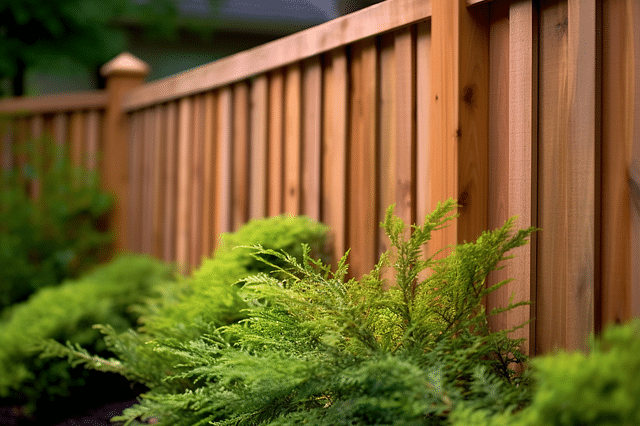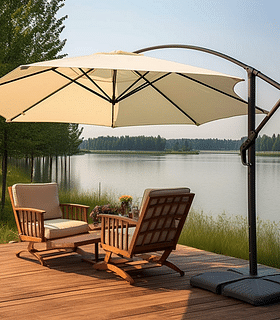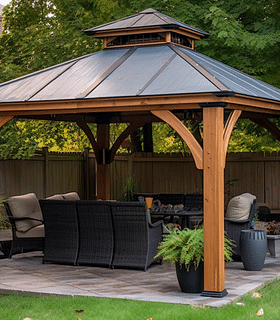How long does a cedar fence last? - Tips for increasing its lifespan
Increase the lifespan of your cedar fence with these expert tips! Find out how long a cedar fence can last and get the lowdown in our latest blog post. Don't miss out, read on now!

How long does a cedar fence last? It's a question that many homeowners ask themselves when considering whether to invest in a cedar fence for their property. After all, a fence is not only a functional addition to your home, but it also enhances the overall aesthetic appeal of your outdoor space.
Imagine this, you spend a good amount of time and money on installing a beautiful cedar fence in your yard, only to find out a few years down the line that it's starting to deteriorate. The last thing anyone wants is a fence that looks worn out and needs constant repairs.
If you're looking for tips on how to increase the lifespan of your cedar fence and make it last for years to come, you've come to the right place. In this blog post, we'll explore the factors that influence the longevity of a cedar fence and provide you with practical advice that will help you maximize its lifespan. So, let's dive in and discover how you can ensure that your cedar fence stands strong, withstands the test of time, and remains a beautiful addition to your property.
Understanding the Lifespan of a Cedar Fence
When it comes to choosing the right type of fence for your property, cedar is a popular choice for many homeowners. Not only does it provide a beautiful and timeless aesthetic, but it also offers durability and a long lifespan when properly maintained. In this section, we will dive deeper into the factors that affect the lifespan of a cedar fence, the average lifespan you can expect, how to determine the lifespan of your specific cedar fence, and how the quality of the cedar can impact its longevity.
What factors affect the lifespan of a cedar fence?
Several factors come into play when considering the lifespan of a cedar fence. These include:
Maintenance: Regular maintenance is crucial in extending the lifespan of a cedar fence. This includes cleaning, sealing, and treating the wood to protect it from moisture, rot, and insect damage.
Climate: The climate in which you live can greatly impact the lifespan of your cedar fence. Extreme weather conditions such as high humidity, heavy rain, freezing temperatures, and prolonged exposure to sunlight can all cause the wood to deteriorate more quickly.
Installation: The way a cedar fence is installed can affect its lifespan. Proper installation techniques, such as using the right type of fasteners and ensuring that the posts are securely anchored in the ground, can significantly increase the longevity of the fence.
Quality of materials: The quality of the cedar used in the fence construction can also impact its lifespan. Higher-quality cedar that is free from knots, cracks, and other imperfections will generally last longer than lower-grade cedar.
What is the average lifespan of a cedar fence?
On average, a well-maintained cedar fence can last anywhere between 15 to 30 years. However, this can vary depending on the factors mentioned above. By taking proper care of your cedar fence and addressing any issues promptly, you can maximize its lifespan and enjoy its beauty for many years to come.
How can you determine the lifespan of your specific cedar fence?
To determine the lifespan of your specific cedar fence, you should consider the factors mentioned earlier. Assess the current condition of your fence, including any signs of rot, insect damage, or warping. If your fence has been consistently well-maintained, it is likely to have a longer lifespan compared to a fence that has been neglected.
Additionally, consulting with a professional fence contractor can provide you with valuable insights and recommendations specific to your fence's condition and environment. They can assess any signs of damage, provide maintenance tips, and help you make an informed decision regarding repairs or replacement.
How does the quality of the cedar affect the fence's lifespan?
The quality of cedar used in a fence can significantly impact its lifespan. Higher-grade cedar that is clear of knots, cracks, and other flaws tends to be more durable and resistant to rot and insect damage. It is important to choose a reputable supplier who sources high-quality cedar to ensure your fence has the best chance of a long lifespan.
In contrast, lower-quality cedar may deteriorate more quickly, requiring more frequent repairs and potentially decreasing the overall lifespan of the fence. Investing in higher-quality cedar upfront can save you time and money in the long run.
Tips for Increasing the Lifespan of Your Cedar Fence
Having a beautiful cedar fence adds charm and privacy to your outdoor space. But like anything exposed to the elements, it requires regular care and maintenance to ensure its longevity. By following a few simple tips, you can increase the lifespan of your cedar fence and keep it looking great for years to come.
Regular Cleaning and Maintenance
One of the key ways to extend the lifespan of your cedar fence is through regular cleaning and maintenance. Over time, dirt, grime, and mold can accumulate on the surface of the wood, leading to discoloration and potential damage. To prevent this, it's important to clean your fence at least once a year, or more frequently if it's exposed to heavy dirt or moisture.
To clean your cedar fence, start by removing any loose debris with a broom or a leaf blower. Next, mix a mild detergent with water and scrub the fence using a soft-bristle brush or a sponge. Rinse with water thoroughly, making sure to remove all the soap residue. Finally, allow the fence to air dry completely before applying any protective finishes.
Applying a Protective Finish
Another important step in increasing the lifespan of your cedar fence is applying a protective finish. A protective finish helps to seal the wood, preventing moisture from seeping in and causing rot or warping. It also adds a layer of defense against UV rays from the sun, which can cause the wood to fade and deteriorate.
There are various types of protective finishes available for cedar fences, including stains, sealants, and paints. Stains are a popular choice for cedar fences as they enhance the natural beauty of the wood while providing excellent protection. Before applying any finish, make sure to clean the fence thoroughly and let it dry completely. Follow the manufacturer's instructions for application and consider reapplying the finish every few years to maintain its effectiveness.
Proper Installation Techniques
Proper installation of your cedar fence is essential for ensuring its longevity. When installing the fence, make sure to use pressure-treated posts or galvanized steel posts to prevent rotting at the ground level. Additionally, leave a small gap between the bottom of the fence panels and the ground to allow for proper air circulation and drainage.
It's also important to set the posts securely in the ground to provide stability for the fence. Dig holes deep enough to accommodate at least one-third of the post's height and fill them with concrete for extra support. Proper installation techniques reduce the risk of the fence leaning or collapsing over time, prolonging its lifespan.
Avoiding Common Causes of Damage
To increase the lifespan of your cedar fence, it's important to be mindful of common causes of damage. Avoid hanging heavy objects on the fence, as the weight can put unnecessary strain on the wood or even cause it to break. Be careful when using landscaping tools near the fence to prevent accidental scratches or dents.
In addition, keep sprinklers or other sources of water away from the fence to minimize exposure to moisture. Excessive moisture can lead to rot and mold growth, which can significantly reduce the lifespan of your cedar fence. By being cautious and proactive, you can prevent avoidable damage and maintain the integrity of your fence.
Protecting Against Insects and Rot
Cedar is naturally resistant to insects and rot, but it's still essential to take precautions to protect your fence. Regularly inspect your fence for any signs of insect infestation or rot, such as holes, crumbling wood, or sagging panels. If you notice any issues, address them promptly to prevent further damage.
To protect against insects, you can use insect-repellent products specifically designed for cedar wood. These treatments can be applied directly to the fence to deter insects and keep your fence looking its best. Additionally, ensure that any vegetation near the fence is trimmed and well-maintained, as overgrown plants can attract pests and promote rot.
Minimizing Exposure to Harsh Weather Conditions
Cedar wood is naturally durable and can withstand various weather conditions, but it's still important to minimize its exposure to harsh elements. Extreme temperature changes, prolonged exposure to sunlight, and excessive moisture can all take a toll on your fence.
Consider planting trees or installing shade structures near your fence to provide some protection from direct sunlight. If your area is prone to heavy rain or snow, ensure that the fence has proper drainage to prevent water from pooling at the base. During winter months, remove any accumulated snow from the fence to prevent excess weight.
By taking these measures to minimize exposure to harsh weather conditions, you can help extend the lifespan of your cedar fence and maintain its beautiful appearance for years to come.
Trending products
Shop outdoor accessoriesFrequently asked questions
- How long does a cedar fence typically last?
- On average, a cedar fence can last around 15 to 20 years with proper maintenance and care.
- What factors can affect the lifespan of a cedar fence?
- Factors such as weather conditions, exposure to sunlight, moisture levels, and regular maintenance can affect the lifespan of a cedar fence.
- How can I increase the lifespan of my cedar fence?
- To increase the lifespan of your cedar fence, it's important to regularly inspect and repair any damages, apply a protective sealant or stain, avoid excess moisture exposure, and trim nearby vegetation.
- Do I need to clean my cedar fence regularly?
- Yes, regular cleaning is recommended to remove dirt, debris, and mold that can potentially deteriorate the wood. Use a mild detergent and a soft brush or cloth to clean the surface.
- Can I paint or stain my cedar fence to extend its lifespan?
- Yes, applying a protective sealant, stain, or paint can help protect the cedar wood against weathering and extend its lifespan. Make sure to choose a product specifically formulated for outdoor use.
- How often should I reapply a protective sealant or stain?
- It is generally recommended to reapply a protective sealant or stain every 2 to 3 years to maintain the fence's appearance and durability. However, the frequency may vary depending on the weather conditions and wear and tear.
- Should I trim vegetation near my cedar fence?
- Keeping vegetation trimmed away from your cedar fence helps to prevent excess moisture accumulation, reduces the risk of mold growth, and minimizes the potential for wood rot.
- What should I do if I notice signs of damage or decay on my cedar fence?
- If you notice signs of damage or decay on your cedar fence, it's best to address the issue promptly. Repair or replace any damaged boards or sections, and consider hiring a professional if the damage is extensive.
- Can I use pressure-treated wood for my fence instead of cedar?
- While pressure-treated wood is more resistant to decay and insects, many people prefer the natural beauty and aroma of cedar. Consider your personal preferences, budget, and the specific needs of your property before making a decision.
- Are there any alternatives to cedar for a long-lasting fence?
- Yes, other wood species such as redwood and tropical hardwoods like ipe and teak are also known for their durability and lifespan. However, they may be more expensive compared to cedar.
Are you looking for more ideas?
Have a look at these other guides about improving your garden and patio to create your dream outdoor space!

Are you looking for more ideas?
-
- Role
- How to effectively clean an outdoor infrared sauna in just a few simple steps
- Description
- Clean your infrared sauna effectively and effortlessly in just a few simple steps. Say goodbye to dirt and grime with our expert cleaning guide.
-
- Role
- Summer Lawn Improvement Tips
- Description
- Achieve a lush and healthy lawn this summer with our expert lawn improvement tips. From proper watering techniques to effective fertilizing, we'll help you transform your lawn into a stunning outdoor oasis. Start implementing these tips today for a greener, more vibrant lawn all summer long.
-
- Role
- Fixing Rusty Patio Chair Legs: A Step-by-Step Guide
- Description
- Revive your outdoor seating with our comprehensive step-by-step guide on fixing rusty patio chair legs. Discover how to assess the damage, remove rust, and protect against future corrosion. Rejuvenate your outdoor space today.
-
- Role
- Cleaning and Maintaining Your Outdoor Cushions: A Simple Guide
- Description
- Learn how to clean and maintain your outdoor cushions to keep them looking fresh and vibrant.



